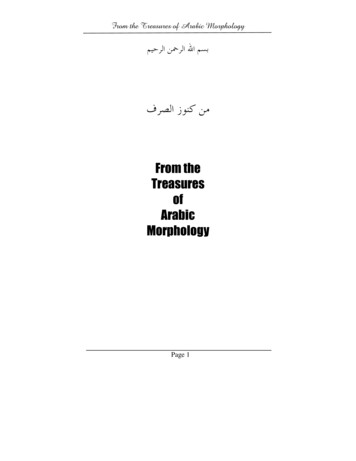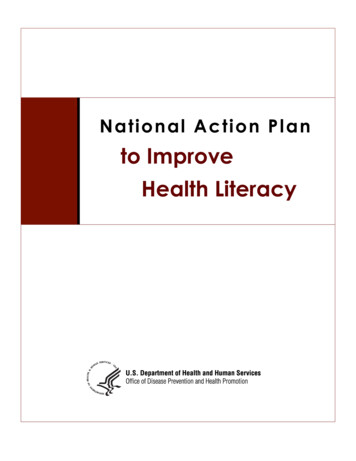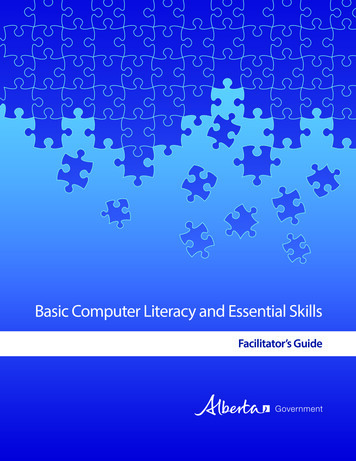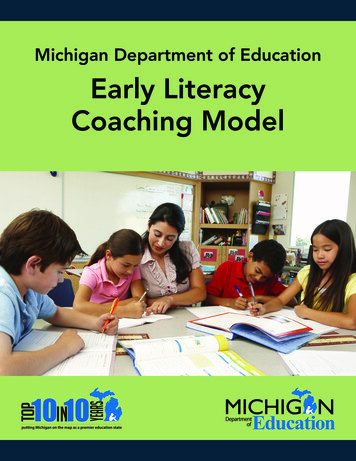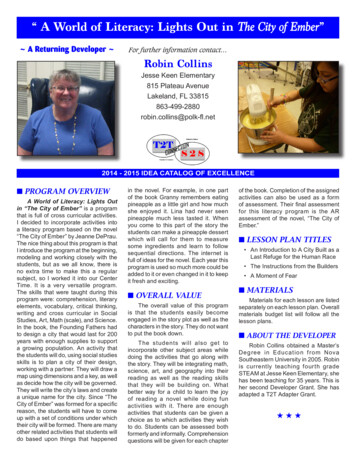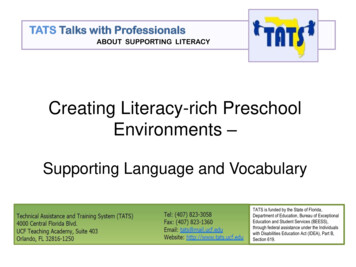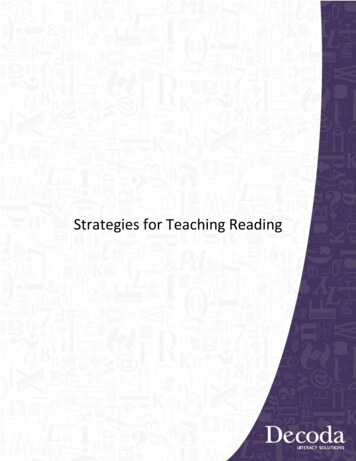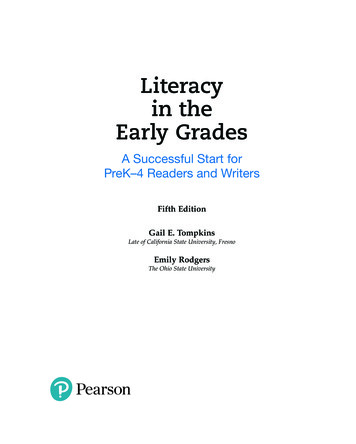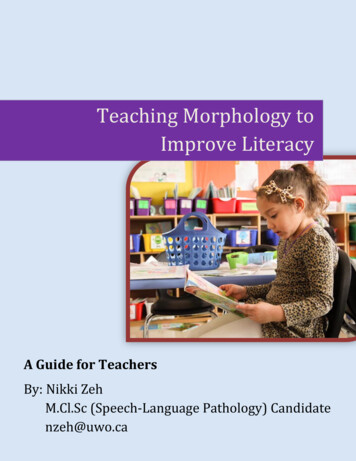
Transcription
Teaching Morphology toImprove LiteracyA Guide for TeachersBy: Nikki ZehM.Cl.Sc (Speech-Language Pathology) Candidatenzeh@uwo.ca
Table of ContentsWhat is morphological awareness? 3Why should I teach morphological awareness? .4Which students will benefit most? .5When should I start teaching morphological awareness? 6What words should I choose to target first? .7What are some resources that I can purchase? .7What activities can I do in my classroom? .8References .112
What is morphological awareness?A morpheme is the smallest unit of meaning. Some words have only one morpheme(e.g., jump, maple, tiger) while many others are made up of two or more morphemes.For instance, the word bananas contains two morphemes:1. “banana” tells us about the fruit2. the suffix “–s” tells us about how many of that fruitTherefore, adding prefixes and suffixes—both of which are examples of morphemes—canalter a word’s meaning (Hennessy & Apel, 2017). Together, prefixes and suffixes areknown as affixes.A root word is the most basic form of a word.Affixes can be added to the root word to change itsmeaning. For example, connect is the root word ofwords such as disconnect, connected, and connecting.Individuals who can consciously recognize,comprehend, and manipulate these small units ofmeaning are engaging in morphologicalawareness (Kirby & Bowers, 2012). In other words,morphological awareness is an understanding thatprefixes and suffixes can be added or taken away tochange the meaning of a word (Ebbers, 2017).The following resources provide comprehensive listsof common English root words, prefixes, and suffixes,as well as their meanings and examples: http://www.prefixsuffix.com/rootchart.php icity/Domain/174/List-ofEnglish-Morphemes.pdf s/vocabulary/pdf/prefixes suffixes.pdf3
Why should I teach morphological awareness?Morphological awareness provides a powerful tool for improving many areas of literacy:Vocabulary comprehension: When a child comes across an unfamiliar word in atext, they can break it apart and use their knowledge of the root, prefixes, and suffixes toinfer the meaning of the whole word (Apel & Henbest, 2016). For example, knowledge ofthe prefix “mis-” meaning “wrongly” can help the student figure out that “mishear” means“to hear incorrectly or wrongly”.Reading aloud: Morphological awareness facilitates reading aloud because it helpsstudents clarify pronunciation (Wolter & Green, 2013). For example, if they can identifythe boundary between the prefix “mis-” and the root “hear”, it is more likely that theywould correctly pronounce the /s/ and /h/ separately, rather than incorrectly as acombination like “sh” as in “ship”.Spelling: Students cannot learn to spell words solely by sounding them out because asingle letter in English can represent more than one sound. Knowledge of morphemes canmake spelling of complex words or spelling exceptions easier for students to remember(Goodwin & Ahn, 2010). For example, even though the words called and bald rhyme,awareness of the past tense morpheme –ed gives an explanation for the different spellings.Phonological awareness: Increasing the salience of written morphology could act asa scaffolding tool to build up awareness of speech sounds in struggling readers. Onestrategy is to link the sounds that make up the word (phonological structure) to it spellingand meaning representation (Bowers, Kirby, & Deacon, 2010). For example, a student mustuse both phonological and morphological awareness to process how the suffix –ian changesboth the pronunciation of the letter “c” and meaning of the word music to musician.Reading comprehension: Since morphological awareness increases processingefficiency and vocabulary knowledge, more cognitive resources are available to process thetext as a whole. Additionally, as a student gets better at identifying words and theirmeanings, reading comprehension improves because he or she has more information tomake inferences and generate an accurate map of the text (Goodwin & Ahn, 2010).4
Which students will benefit most?Typically achieving students: Explicitteaching of morphological awareness willbenefit all students in your class (Bowers etal., 2010). Morphological awarenessenhances students’ existing skills byproviding them with an additional tool to usewhen they encounter a challenging word(Goodwin, Lipsky, & Ahn, 2012).Students with language and literacy difficulties: Poor phonological awarenessis a common characteristic of struggling readers (Bowers et al., 2010). Children withlanguage difficulties may not have a strong morphological knowledge base and thus areless effective at applying this valuable strategy on their own during reading or writing(Wolter & Green, 2013). With repeated practice in the classroom, these students maybecome more comfortable independently applying this strategy, and can use this as acompensatory tool to help overcome their difficulties of reading words based on theirsounds. Furthermore, breaking down an unfamiliar word into chunks that they understandmakes decoding and accessing meaning easier. This leaves more mental resourcesavailable for the student to use for comprehension of the text as a whole (Nagy, BerningerAbbott, Vaughan, & Vermeulen, 2003).English language learners: Pointing out cognates (similar units of meaning betweenthe native language and English) can augment an English language learner’s understandingof culturally decontextualized text (Goodwin et al., 2012). For instance, the word bicyclettein French is similar to its English equivalent bicycle. If you are familiar with bothlanguages, you can point out the similarity between bicycle and bicyclette, and inquire as towhether they mean the same thing. Then, you can extend this to other French wordsbeginning with the morpheme bi-, such as bilingue (bilingual), biannuel (biannual), andbidirectionnel (bidirectional). Using cognates to decipher unfamiliar prefixes, suffixes, androot words can strengthen reading comprehension and vocabulary for English languagelearners (Goodwin et al., 2012).5
When should I start teaching morphological awareness?By the age of ten, morphological awareness is a better predictor of decoding abilitythan is phonological awareness (Mann & Singson, 2003). Despite this, phonologicalawareness commonly overshadows morphological awareness in that students are moreoften encouraged to sound out unfamiliar words than to break down these words intomeaningful units. While research has not clearly established at which age morphologicalawareness instruction is most effective, it has been shown that children as young as fouryears old have some morphological awareness (Berko, 1958).There are many studies that support addressing morphological awareness in theearly years in elementary school, whereas traditionally it has been a focus in middle schooland high school. Nagy et al. (2003) emphasized that struggling readers may benefit fromexplicit morphological awareness instruction as early as grade two. The authors evaluated98 second-graders who were considered below-average readers and found a strongrelationship between the students’ morphological awareness and their reading abilities.Therefore, there is value in addressing morphological awareness early on inelementary school so that students can use this knowledge as a tool to aid with literacy.Whereas phonemes must be combined to create meaning, morphemes are meaningful ontheir own. Thus, morphemes are more salient and easier to access, which allows studentsto complete more challenging tasks at the morpheme level than they can at the phonemelevel (Goodwin & Ahn, 2010). Forinstance, care and careful share acommon meaningful unit, whereaswords that differ by one phoneme(e.g., cat, mat) do not. The importanceof this becomes apparent whenconsidering that 60% of new wordsthat students read are made up offamiliar morphemes that can lead thereader to its meaning (Carlisle, 2000).6
What words should I choose to target first?Boosting your students’ levels of motivation and ensuring they have many successfulencounters with the new material are two very important factors when introducingmorphological awareness (Ebbers, 2017):Frequency: Select familiar roots, prefixes, and suffixes that commonly appear in theireveryday life. For instance, students can easily grasp the meaning of the prefix un- meaning“not” when provided with recognizable examples such as unlock, uncover, or unsafe. Incontrast, words such as veracity or procrastinate are much more unclear.Imageability: Choose words that are concrete so that it is easy for students to create amental picture or even a drawing. For example, raining is easier to visualize than anabstract word such as successful.Transparency: Pick words that made up of “transparent” morphemes, meaning that it isobvious how each morpheme contributes to the meaning of the word. For example, it iseasier for students to understand that beautiful means “full of beauty”, whereas themeaning of the word assignment is less apparent from its morphemes.What are some resources that I can purchase? Word Stems Combo by Super Duper Publications ( 79.99) id PRE500&s word-stemscombo&lid 41E46A95#.WjRqj0qnE2w Morphology Practice Packs by Emily Gibbons ( 6.99) Prefixes: Orton-Gillingham-2952472 Suffixes: Orton-Gillingham-2971590 Book: Ish by Peter H. Reynolds ( 4.95) eter-h-reynolds/ Book: Red Hot Root Words by Dianne Draze ( 18.19) s-book-1-diannedraze/1007435871 Prefixes, Suffixes, Root Words eWorkbook by ECS Learning Systems (12.99) -2-grade-3-ebook/7
What activities I can do in my classroom?Activity 1: Find the RootsObjective: The students will understand the concept of root words.Task: Explain to your students that the root word is the main word in a longer word. Workthrough examples, and provide your students with a list of complex words for them topractice identifying root words.Example complex word list: nosey, hopeless, sleeping, carefully, breakable, tossed,troubling, dogs, judgmental, enjoymentActivity 2: Fix the Prefixes and SuffixesObjective: The student will understand the concept of affixes.Task: Explain to your students that there are little parts added to the beginning of theword called prefixes and added to the end of the words called suffixes, and these prefixesand suffixes change the meaning of the word to make a new word. Direct your students to“fix” the broken root word by matching it with the correct prefix or suffix. Discuss howadding the prefixes and suffixes changes the meaning of each root word.Example: -ish-y-ed-ion-ful-ing-ly-able-lessActivity 3: Word SortObjective: The students will recognize word families based on morphemes.Task: Instruct the students to examine and sort the listed words based on theirmorphemes. Then, encourage them to predict the meaning of the morpheme based ontheir current knowledge and the patterns they observe.Example word list: judgment, disagree, colourful, argument, distrust, eventful, apartment,discomfort, fearful, hateful, disadvantage, wonderful, resentment, discontent, statement8
Activity 4: Big Word BreakdownObjective: The students will use their knowledge of morphemes to decipher the meaningof unfamiliar words.Task: Instruct the students to skim a chapter of their textbook (for any subject) and writedown 10 big words. For each word, have the student identify the root word and anyprefixes or suffixes. They should write down the meaning of each of these parts, and thenuse this to infer a definition of the whole word.Example: subsequentlyPrefix: sub- underRoot: sequent following in a sequenceSuffix: -ly characterized by; act in that wayPossible meaning: acting in a way that follows “under” something else in asequenceStudent friendly definition: something that occurs subsequently to somethingelse occurs later than or after it in timeActivity 5: SpotlightObjective: The student will apply their knowledge of morphological awareness todetermine the meaning of curriculum-related words.Task: Select one or two complex, curriculum-specific words from your lesson. When itcomes up during your lesson, explicitly assess the word’s morphologic structure andinquire about its meaning.Example: When teaching shapes in your math class, write the word “triangle”. Explain thatthe prefix “tri” means three, and this shape is called a “triangle” because it has three angles.Relate this to other words that share this prefix, such as tricycle, triceratops, and triplet.Activity 6: Building BlocksObjective: The student will blend prefixes, suffixes, and roots to create complex words.Task: Make flashcards with a variety of prefixes, suffixes, and roots. Instruct the studentsto physically manipulate the flash cards to create as many real words as they can.Encourage the students to compare and contrast the meanings of words. Alternatively,students could also build words by assembling large pieces of Lego that have prefixes,suffixes, and roots written on them.Example list: en-, content, un-, joy, light, -ment, -al, courage, -ous, dis-, -ly, re-9
Activity 7: Build the Word, Use the WordObjective: The students will apply their knowledge of units of meaning by using them in asentence.Task: Provide the students with a list of root words plus one prefix or suffix. Have thestudents add the prefix or suffix to the root word and then use the new word in a sentence.Example: Suffix: -less. Root words: fear, hope, thought.Fear fearless. The fearless firefighter ran into the burning building.Activity 8: Sort ‘n’ SpellObjective: The students will devise a spelling rule based on knowledge of affixes.Task: Provide the students with a list of words and have them group the words accordingto spelling. The two groups should be distinguished by a pair of affixes that mean the samething but are spelled differently. Encourage the students to examine the words to come upa rule for when to use each of the affixes.Example list: honorable, visible, predictable, enjoyable, fashionable, edibleRule: When the root word looks like a whole word, add the suffix –able.When the root word is not a full word, use the suffix –ibleActivity 9: Rocking RootsObjective The students will understand how adding differentprefixes and suffixes to a root words changes its meaning.Task: Help the students create a foldable model, as depicted inthe figure to the right. Elicit a discussion on what the root wordmeans on its own, and how adding different prefixes and suffixeschanges its meaning.Example: In the figure to the right, the root “port” is used as thecentral focus, and the student can modify the prefix and/or suffixdisplayed by pulling on the tabs. Examples of adjustments thatcan be made to the root word “port” are: transportable,important, supporting, deported.For more activity ideas, check out this document from the Florida Center for ReadingResearch (2007): .pdf10
ReferencesApel, K., & Henbest, V. S. (2016). Affix meaning knowledge in first through third gradestudents. Language, Speech, and Hearing Services in Schools, 47(2), 148-156.Berko, J. (1958). The child’s learning of English morphology (Doctoral dissertation).Radcliffe College, Cambridge, MA.Bowers, P. N., Kirby, J. R. & Deacon, S. H. (2010). Effects of morphological instruction onliteracy skills: A systematic review of the literature. Review of Educational Research,80(2), 144-179.Carlisle, J. F. (2000). Awareness of the structure and meaning of morphologically complexwords: Impact on reading. Reading and Writing, 12(3), 169-190.Ebbers, S. M. (2017). Morphological awareness strategies for the general and specialeducation classroom: A vehicle for vocabulary enhancement. Perspectives onLanguage and Literacy, 42(2), 29-34.Goodwin, A. P., & Ahn, S. (2010). A meta-analysis of morphological interventions: Effectson literacy achievements of children with literacy difficulties. Annals of Dyslexia, 60,183-208.Goodwin, A. P., Lipsky, M., & Ahn, S. (2012). Word detectives: Using units of meaning tosupport literacy. The Reading Teacher, 65(7), 461-470.Hennessy, N., & Apel, K. (2017). Morphological awareness: How the pieces add up.Perspectives on Langauge and Literacy, 43, 7-9.Kirby, J. R. & Bowers, P. N. (2012). What works? Research into practice. Retrieved e/research/WW Morphology.pdfMann, V. & Singson, M. (2003). Linking morphological knowledge to English decodingability: Large effects of little suffixes. In E. Assink & D. Sandra (Eds.), Readingcomplex words: Cross-language studies (1-25). New York: Plenum Publishers.Nagy, W., Berninger, V. W., Abbott, R. D., Vaughan, K., & Vermeulen, K. (2003). Relationshipof morphology and other language skills to literacy skills in at-risk second-gradereaders and at-risk fourth grade writers. Journal of Educational Psychology, 95(4),730-742.University of Michigan. Morphological Awareness. Retrieved yslexia-school/morphologicalawarenessWolter, J. A., & Green, L. (2013). Morphological awareness intervention in school-agechildren with language and literacy deficits: A case study. Topics in LanguageDisorders, 33(1), 27-41.11
Pictures obtained eo.com/19074805512
alter a word's meaning (Hennessy & Apel, 2017). Together, prefixes and suffixes are known as affixes. A root word is the most basic form of a word. Affixes can be added to the root word to change its meaning. For example, connect is the root word of words such as disconnect, connected, and connecting. Individuals who can consciously recognize,
